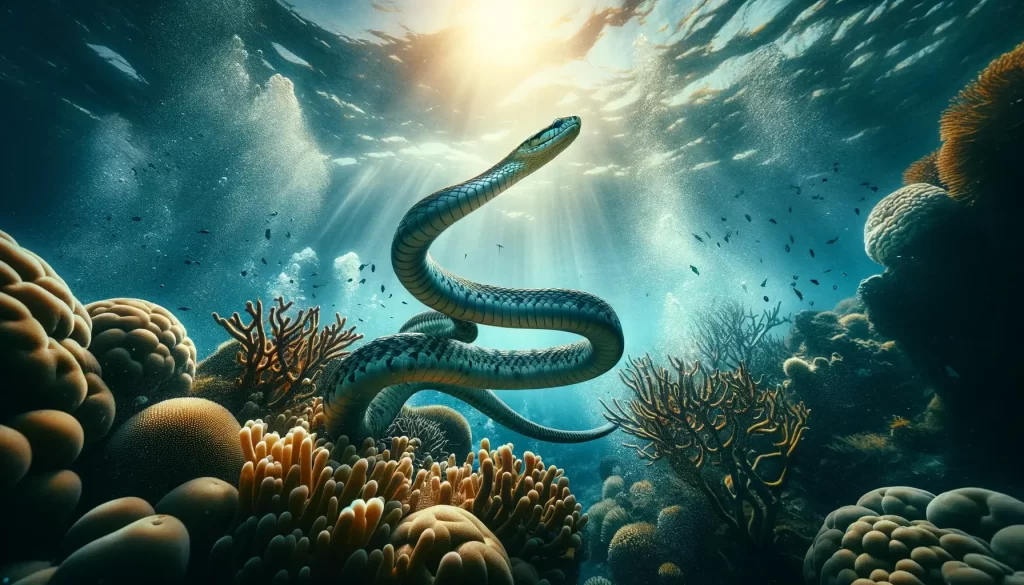
You’ve probably heard of snakes, but have you ever wondered about their aquatic counterparts? Sea snakes, as the name suggests, are snakes that have adapted to life in the water.
One fascinating aspect of these creatures is their ability to hold their breath for extended periods of time.
But just how long can a sea snake stay underwater? In this article, we’ll explore the remarkable diving capabilities of sea snakes and uncover the secrets behind their impressive breath-holding abilities.
Prepare to be amazed by the incredible endurance of these ocean-dwelling serpents.
Physiology of Sea Snakes
Sea snakes have evolved unique physiological adaptations that allow them to thrive in their aquatic environment.
One of the most notable adaptations is their respiration system, which enables them to breathe efficiently underwater.
Unlike most land-dwelling snakes, sea snakes have a specialized lung structure that allows them to take in oxygen from the air, which they store for later use during their dives.
Additionally, they possess an intricate network of blood vessels that helps transport oxygen throughout their bodies.
Respiration in sea snakes
Sea snakes respire through their lungs, much like humans and other mammals. However, their respiratory system has adapted to meet the challenges of life underwater.
When at the water’s surface, sea snakes come up for air, filling their lungs with oxygen-rich air.
They can also ventilate their lungs by extending their nostrils above the water surface.
As they dive beneath the water, sea snakes rely on the stored oxygen in their lungs to sustain them until they resurface again.
Lung capacity of sea snakes
The lung capacity of sea snakes is impressive compared to their land-dwelling counterparts.
The lungs of sea snakes can expand significantly, allowing them to hold a greater volume of air.
This increased lung capacity enables them to store more oxygen, extending their breath-holding ability during dives.
The lung capacity of sea snakes is, to some extent, species-specific, with larger species generally having larger lungs and greater lung volumes.
Oxygen storage in sea snakes
Sea snakes have a unique adaptation that allows them to store oxygen efficiently. Within their bodies, sea snakes have specialized tissues that can absorb and store oxygen for prolonged periods.
These tissues, known as blood sinuses, act as oxygen reservoirs, providing a steady supply of oxygen to the snake’s vital organs during dives.
This adaptation enables sea snakes to stay submerged for extended periods, maximizing their chances of finding prey or evading predators.
Adaptations for Underwater Life
Sea snakes possess an array of adaptations that enhance their ability to survive and thrive in an underwater environment.
These adaptations range from behavioral changes to structural modifications in their bodies.
Diving behavior of sea snakes
Sea snakes are well-known for their diving behavior. They are highly buoyant, which allows them to effortlessly glide through the water column in search of food or shelter.
Unlike land snakes, sea snakes are excellent swimmers and can navigate the ocean with ease.
They typically move using lateral undulations of their bodies, propelling themselves forward in a serpentine fashion.
These adaptations in diving behavior enable sea snakes to explore their surroundings effectively and cover large distances.
Glands and specialized structures
Sea snakes possess specialized glands and structures that aid in their survival underwater.
The cephalic glands, located near their mouths, produce a venom used for defense and subduing prey.
This venom is neurotoxic and can immobilize fish, providing sea snakes with a reliable food source.
Additionally, they have enlarged nostrils and valves that allow them to retain air within their lungs, reducing the risk of water entering their respiratory system during dives.
Metabolic adaptations
To sustain their prolonged dives, sea snakes have undergone metabolic adaptations. These adaptations allow them to slow down their metabolic rate and conserve energy, minimizing the oxygen consumption during dives.
By reducing their metabolic demands, sea snakes can extend their breath-holding ability and maximize their time underwater.
This metabolic flexibility is crucial for their survival, as it enables them to hunt and forage efficiently without the need for frequent trips to the surface.
Factors Affecting Breath-holding Ability
Several factors influence the breath-holding ability of sea snakes. These factors can vary among species, individuals, and across different environmental conditions.
Species variation
Breath-holding abilities can vary significantly among different species of sea snakes. Larger species tend to have longer breath-holding times, as they have larger lung volumes and a greater oxygen storage capacity. The specific hunting and foraging strategies of each species can also impact their breath-holding ability. Some sea snakes may engage in more active pursuits, requiring more oxygen and shortening their breath-holding times, while others may employ more patient, ambush-style tactics that allow them to hold their breath for longer durations.
Size and age
Size and age can also play a role in determining the breath-holding ability of sea snakes. Larger individuals generally have larger lung capacities, enabling them to store more oxygen and hold their breath for longer periods. Similarly, older sea snakes may have developed more efficient physiological adaptations, allowing them to maximize their breath-holding ability. However, it is essential to consider that individual variation can occur within populations, and not all larger or older sea snakes will necessarily have superior breath-holding abilities.
Environmental conditions
The environmental conditions in which sea snakes reside can have a profound impact on their breath-holding ability. Factors such as water temperature, salinity, and oxygen availability in the surrounding water can influence the snake’s physiology and metabolic rates. Warmer waters generally lead to increased metabolic rates, resulting in higher oxygen consumption and shorter breath-holding times. Additionally, the presence of predators or disturbances in the environment can also affect the snake’s stress levels and, consequently, their ability to hold their breath.
Duration of Breath-holding
Sea snakes are known for their impressive breath-holding abilities, which allow them to remain underwater for extended periods. The duration of their breath-holding can vary depending on several factors, including species, individual characteristics, and environmental conditions.
Typical breath-holding times
On average, sea snakes can hold their breath for approximately 15-30 minutes. This remarkable breath-holding ability exceeds that of many other marine animals. However, it is important to note that these are average values and can vary across different species of sea snakes. Larger species, such as the Olive Sea Snake, have been observed to hold their breath for up to 2 hours, while smaller species may have shorter breath-holding times. Moreover, individual variability within species can also lead to differences in breath-holding durations.
Records for longest breath-holding
Some sea snakes have achieved extraordinary breath-holding records. The Black-banded Sea krait, a highly specialized sea snake species, holds the record for the longest recorded breath-holding time among snakes. It has been reported to hold its breath for up to 3.5 hours. This exceptional ability is thought to be due to the snake’s unique physiological adaptations, such as its increased lung volume and efficient oxygen storage mechanisms.
Final Thoughts
In conclusion, sea snakes showcase a remarkable set of adaptations that equip them for a life submerged in aquatic environments.
Their specialized respiratory systems, expansive lung capacities, and metabolic adjustments are central to their extended breath-holding abilities, a critical aspect of their underwater survival strategy.
Influenced by a variety of factors including species differences, individual characteristics, and environmental conditions, their breath-holding durations can vary significantly, with some species demonstrating exceptional capabilities.
These fascinating creatures, capable of remaining underwater for hours at a time, embody the rich diversity and adaptability of marine life, inviting further exploration into the captivating world of the deep sea.



